Page 533 of 658
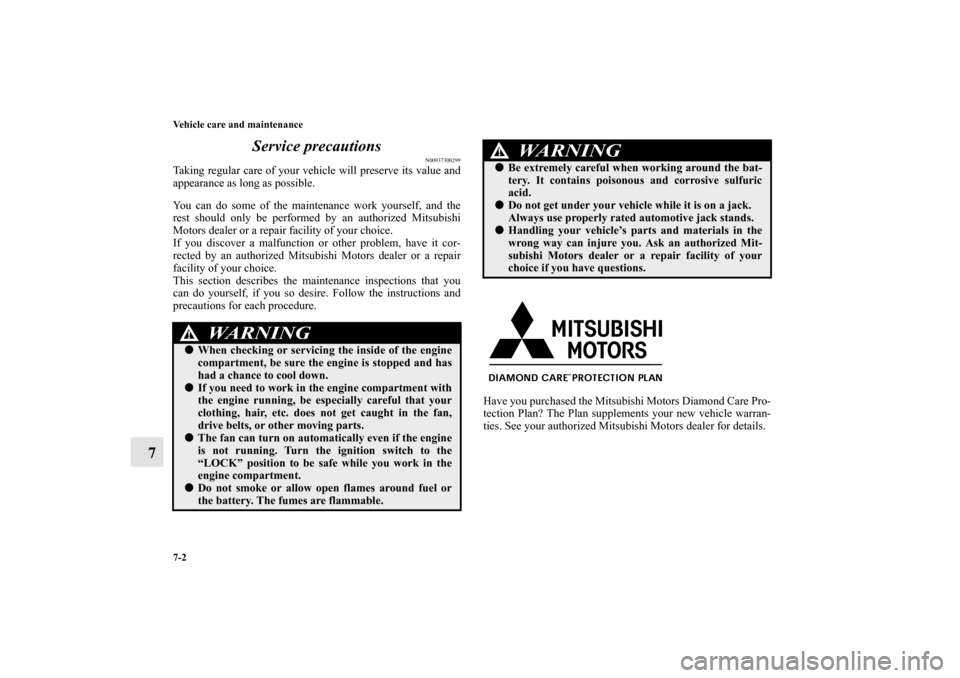
7-2 Vehicle care and maintenance
7Service precautions
N00937300299
Taking regular care of your vehicle will preserve its value and
appearance as long as possible.
You can do some of the maintenance work yourself, and the
rest should only be performed by an authorized Mitsubishi
Motors dealer or a repair facility of your choice.
If you discover a malfunction or other problem, have it cor-
rected by an authorized Mitsubishi Motors dealer or a repair
facility of your choice.
This section describes the maintenance inspections that you
can do yourself, if you so desire. Follow the instructions and
precautions for each procedure.
Have you purchased the Mitsubishi Motors Diamond Care Pro-
tection Plan? The Plan supplements your new vehicle warran-
ties. See your authorized Mitsubishi Motors dealer for details.
WA R N I N G
!�
When checking or servicing the inside of the engine
compartment, be sure the engine is stopped and has
had a chance to cool down.
�
If you need to work in the engine compartment with
the engine running, be especially careful that your
clothing, hair, etc. does not get caught in the fan,
drive belts, or other moving parts.
�
The fan can turn on automatically even if the engine
is not running. Turn the ignition switch to the
“LOCK” position to be safe while you work in the
engine compartment.
�
Do not smoke or allow open flames around fuel or
the battery. The fumes are flammable.
�
Be extremely careful when working around the bat-
tery. It contains poisonous and corrosive sulfuric
acid.
�
Do not get under your vehicle while it is on a jack.
Always use properly rated automotive jack stands.
�
Handling your vehicle’s parts and materials in the
wrong way can injure you. Ask an authorized Mit-
subishi Motors dealer or a repair facility of your
choice if you have questions. WA R N I N G
!
BK0103001US.book 2 ページ 2009年8月20日 木曜日 午前10時45分
Page 539 of 658
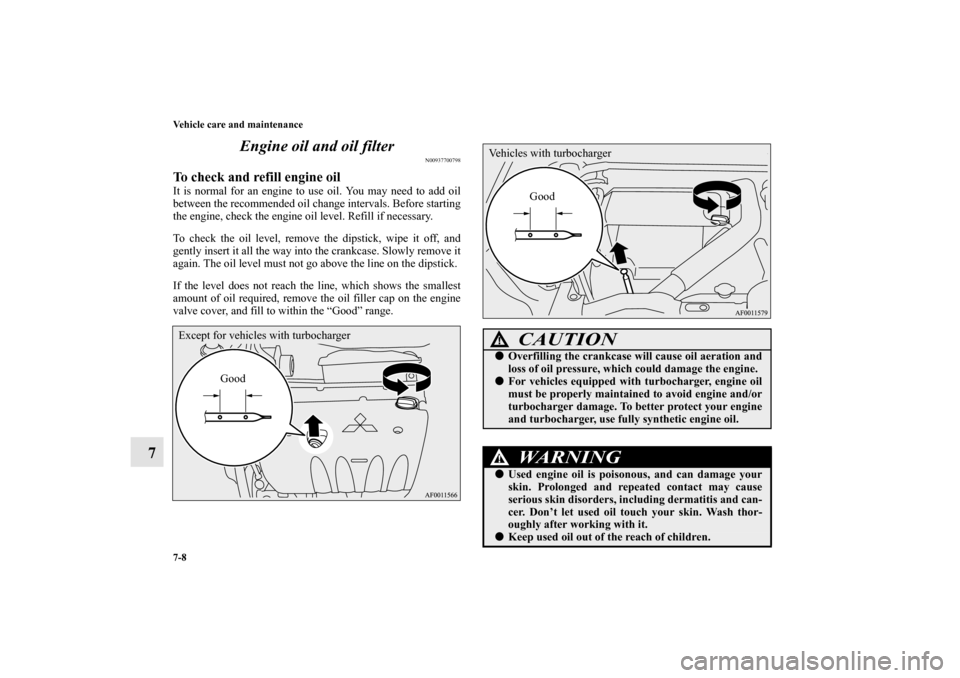
7-8 Vehicle care and maintenance
7Engine oil and oil filter
N00937700798
To check and refill engine oil It is normal for an engine to use oil. You may need to add oil
between the recommended oil change intervals. Before starting
the engine, check the engine oil level. Refill if necessary.
To check the oil level, remove the dipstick, wipe it off, and
gently insert it all the way into the crankcase. Slowly remove it
again. The oil level must not go above the line on the dipstick.
If the level does not reach the line, which shows the smallest
amount of oil required, remove the oil filler cap on the engine
valve cover, and fill to within the “Good” range.
Good Except for vehicles with turbocharger
CAUTION
!�
Overfilling the crankcase will cause oil aeration and
loss of oil pressure, which could damage the engine.
�
For vehicles equipped with turbocharger, engine oil
must be properly maintained to avoid engine and/or
turbocharger damage. To better protect your engine
and turbocharger, use fully synthetic engine oil.WA R N I N G
!�
Used engine oil is poisonous, and can damage your
skin. Prolonged and repeated contact may cause
serious skin disorders, including dermatitis and can-
cer. Don’t let used oil touch your skin. Wash thor-
oughly after working with it.
�
Keep used oil out of the reach of children.
Vehicles with turbocharger
Good
BK0103001US.book 8 ページ 2009年8月20日 木曜日 午前10時45分
Page 542 of 658
Vehicle care and maintenance
7-11
7
To replace the oil filter
N00955100026
The oil filter should be replaced at the time or mileage speci-
fied in the “WARRANTY AND MAINTENANCE MAN-
UAL”.
Only use high quality replacement filters on this vehicle. The
manufacturer’s specifications for Genuine Mitsubishi oil filters
require that the filter can withstand a pressure of 256 psi
(1.8 MPa). A Genuine Mitsubishi oil filter is the best replace-
ment filter.
Follow the installation instructions printed on the filter.
Engine coolant
N00937800454
To check the coolant level The coolant reserve tank (A) lets you quickly see when you
need to add coolant. When the engine is cold, the level in the
reserve tank should be between the “FULL” and “LOW”
marks. The radiator usually stays full so there is no reason to
remove the radiator cap (B) except when you check the coolant
freeze point or replace the antifreeze coolant.
BK0103001US.book 11 ページ 2009年8月20日 木曜日 午前10時45分
Page 543 of 658
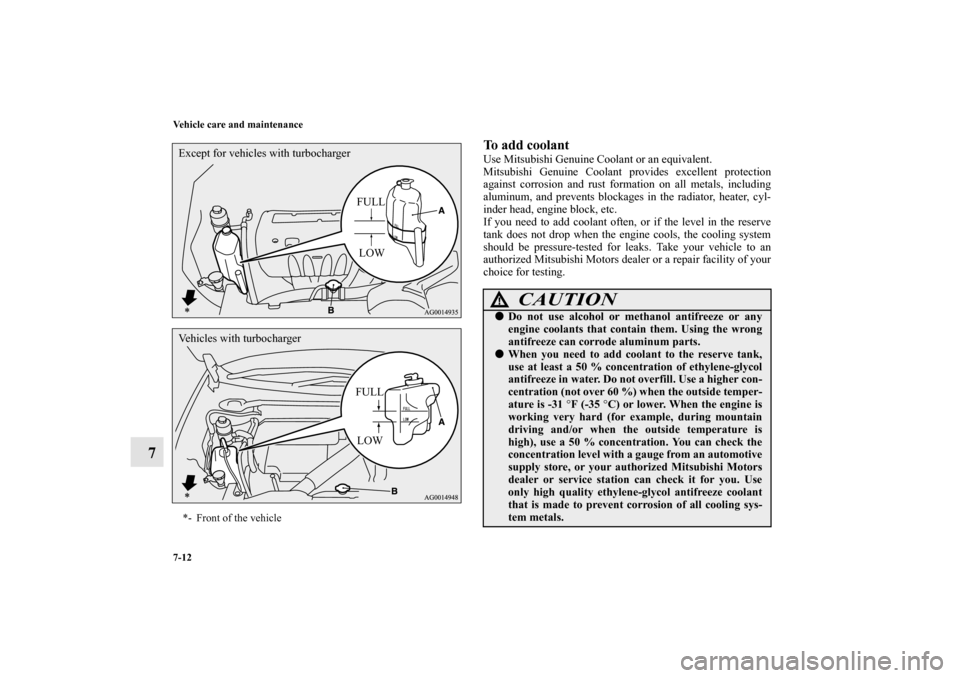
7-12 Vehicle care and maintenance
7
To add coolant Use Mitsubishi Genuine Coolant or an equivalent.
Mitsubishi Genuine Coolant provides excellent protection
against corrosion and rust formation on all metals, including
aluminum, and prevents blockages in the radiator, heater, cyl-
inder head, engine block, etc.
If you need to add coolant often, or if the level in the reserve
tank does not drop when the engine cools, the cooling system
should be pressure-tested for leaks. Take your vehicle to an
authorized Mitsubishi Motors dealer or a repair facility of your
choice for testing.
*- Front of the vehicle
FULL
LOW Except for vehicles with turbocharger
Vehicles with turbocharger
FULL
LOW
CAUTION
!�
Do not use alcohol or methanol antifreeze or any
engine coolants that contain them. Using the wrong
antifreeze can corrode aluminum parts.
�
When you need to add coolant to the reserve tank,
use at least a 50 % concentration of ethylene-glycol
antifreeze in water. Do not overfill. Use a higher con-
centration (not over 60 %) when the outside temper-
ature is -31 °F (-35 °C) or lower. When the engine is
working very hard (for example, during mountain
driving and/or when the outside temperature is
high), use a 50 % concentration. You can check the
concentration level with a gauge from an automotive
supply store, or your authorized Mitsubishi Motors
dealer or service station can check it for you. Use
only high quality ethylene-glycol antifreeze coolant
that is made to prevent corrosion of all cooling sys-
tem metals.
BK0103001US.book 12 ページ 2009年8月20日 木曜日 午前10時45分
Page 544 of 658
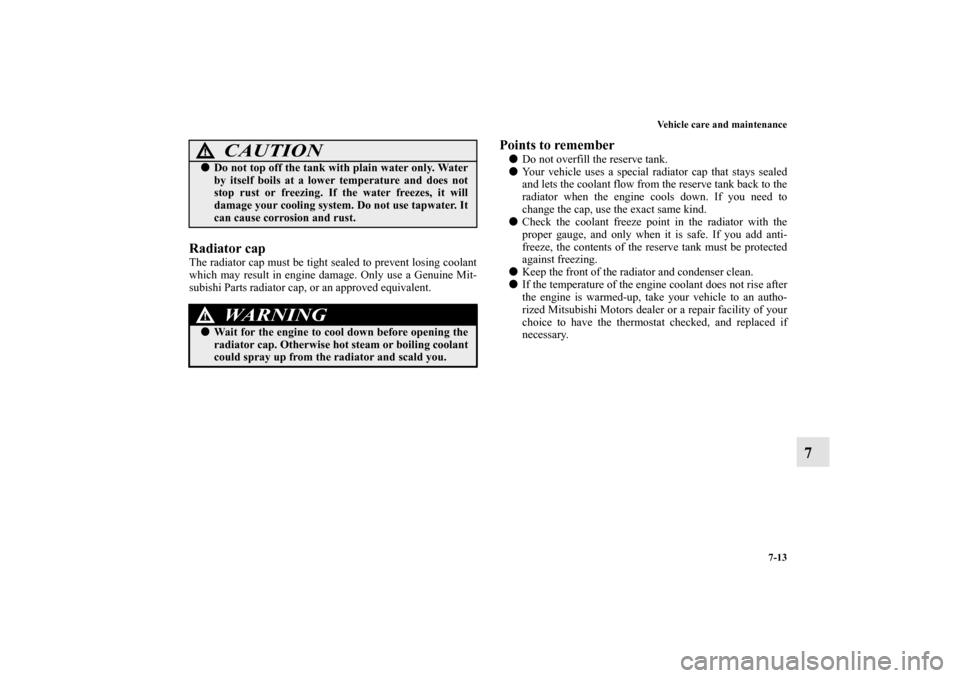
Vehicle care and maintenance
7-13
7
Radiator capThe radiator cap must be tight sealed to prevent losing coolant
which may result in engine damage. Only use a Genuine Mit-
subishi Parts radiator cap, or an approved equivalent.
Points to remember �
Do not overfill the reserve tank.
�
Your vehicle uses a special radiator cap that stays sealed
and lets the coolant flow from the reserve tank back to the
radiator when the engine cools down. If you need to
change the cap, use the exact same kind.
�
Check the coolant freeze point in the radiator with the
proper gauge, and only when it is safe. If you add anti-
freeze, the contents of the reserve tank must be protected
against freezing.
�
Keep the front of the radiator and condenser clean.
�
If the temperature of the engine coolant does not rise after
the engine is warmed-up, take your vehicle to an autho-
rized Mitsubishi Motors dealer or a repair facility of your
choice to have the thermostat checked, and replaced if
necessary.
�
Do not top off the tank with plain water only. Water
by itself boils at a lower temperature and does not
stop rust or freezing. If the water freezes, it will
damage your cooling system. Do not use tapwater. It
can cause corrosion and rust. WA R N I N G
!�
Wait for the engine to cool down before opening the
radiator cap. Otherwise hot steam or boiling coolant
could spray up from the radiator and scald you. CAUTION
!
BK0103001US.book 13 ページ 2009年8月20日 木曜日 午前10時45分
Page 552 of 658
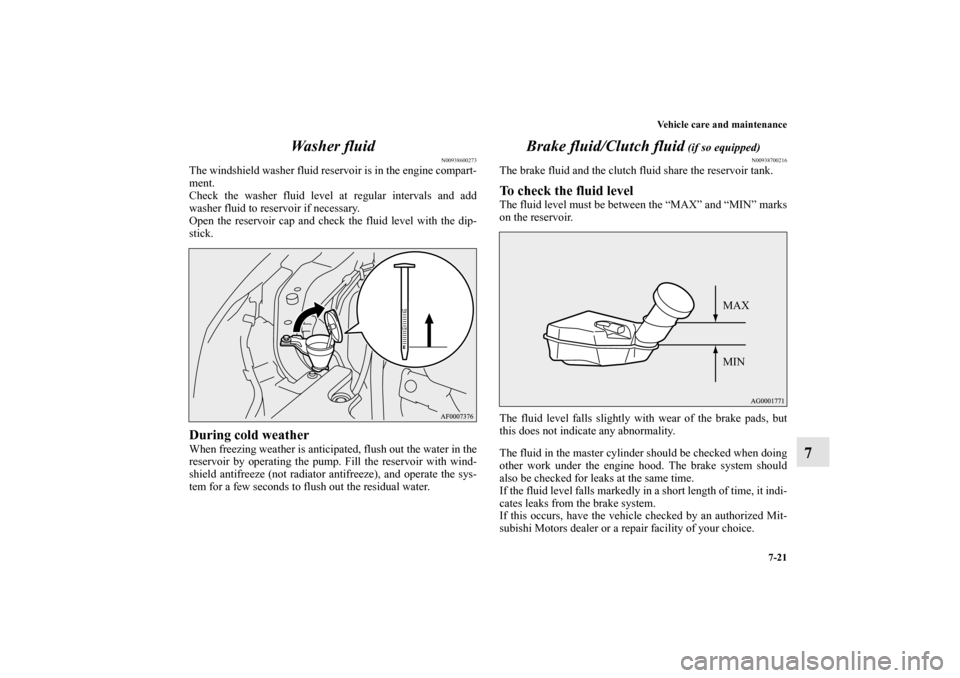
Vehicle care and maintenance
7-21
7 Wa s h e r f l u i d
N00938600273
The windshield washer fluid reservoir is in the engine compart-
ment.
Check the washer fluid level at regular intervals and add
washer fluid to reservoir if necessary.
Open the reservoir cap and check the fluid level with the dip-
stick.During cold weatherWhen freezing weather is anticipated, flush out the water in the
reservoir by operating the pump. Fill the reservoir with wind-
shield antifreeze (not radiator antifreeze), and operate the sys-
tem for a few seconds to flush out the residual water.
Brake fluid/Clutch fluid
(if so equipped)
N00938700216
The brake fluid and the clutch fluid share the reservoir tank.To check the fluid levelThe fluid level must be between the “MAX” and “MIN” marks
on the reservoir.
The fluid level falls slightly with wear of the brake pads, but
this does not indicate any abnormality.
The fluid in the master cylinder should be checked when doing
other work under the engine hood. The brake system should
also be checked for leaks at the same time.
If the fluid level falls markedly in a short length of time, it indi-
cates leaks from the brake system.
If this occurs, have the vehicle checked by an authorized Mit-
subishi Motors dealer or a repair facility of your choice.
MAX
MIN
BK0103001US.book 21 ページ 2009年8月20日 木曜日 午前10時45分
Page 553 of 658
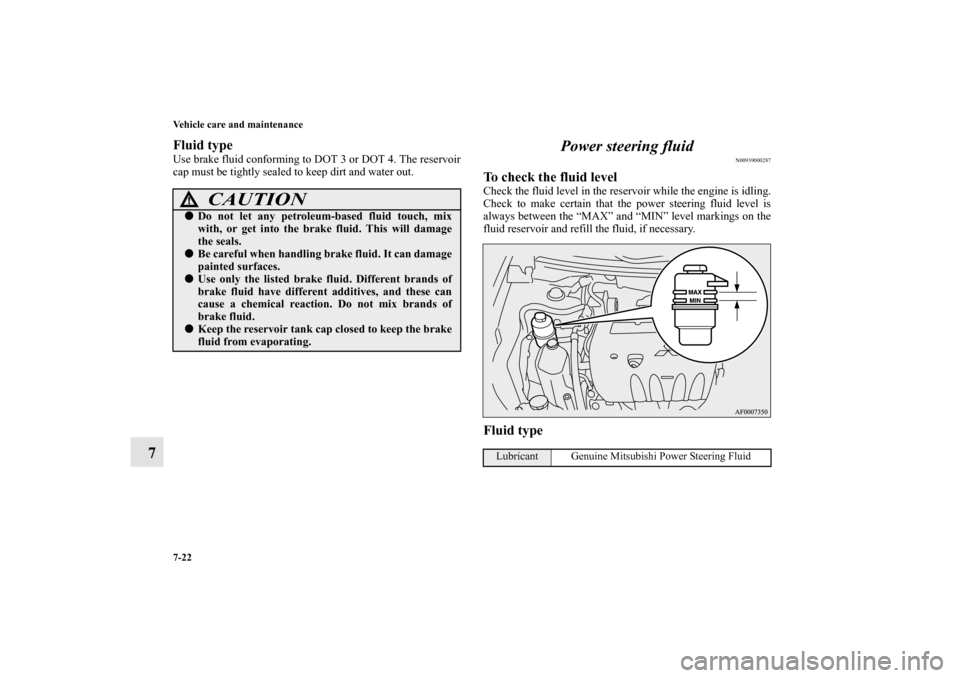
7-22 Vehicle care and maintenance
7
Fluid typeUse brake fluid conforming to DOT 3 or DOT 4. The reservoir
cap must be tightly sealed to keep dirt and water out.
Power steering fluid
N00939000287
To check the fluid levelCheck the fluid level in the reservoir while the engine is idling.
Check to make certain that the power steering fluid level is
always between the “MAX” and “MIN” level markings on the
fluid reservoir and refill the fluid, if necessary.Fluid type
CAUTION
!�
Do not let any petroleum-based fluid touch, mix
with, or get into the brake fluid. This will damage
the seals.
�
Be careful when handling brake fluid. It can damage
painted surfaces.
�
Use only the listed brake fluid. Different brands of
brake fluid have different additives, and these can
cause a chemical reaction. Do not mix brands of
brake fluid.
�
Keep the reservoir tank cap closed to keep the brake
fluid from evaporating.
Lubricant Genuine Mitsubishi Power Steering Fluid
BK0103001US.book 22 ページ 2009年8月20日 木曜日 午前10時45分
Page 554 of 658
Vehicle care and maintenance
7-23
7 Battery
N00939100826
The condition of the battery is very important for quick starting
and to keep the vehicle’s electrical system working properly.
Check the battery regularly. Removing and installing the battery upper cover
(vehicles equipped with turbocharger)
N00901300025
To r e m o v e1. Remove the two clips (A), and then remove the air duct
(B).
WA R N I N G
!�
An SRS airbag sensor is located in the front of the
engine compartment near the battery.
When checking or replacing the battery, or when
working around this area, do not strike or damage
this sensor.WA R N I N G
!�
Turn the ignition switch to the “LOCK” position on
vehicle. Make sure that your clothes cannot be
caught by the fan or drive belt. Personal injury
could result.
BK0103001US.book 23 ページ 2009年8月20日 木曜日 午前10時45分